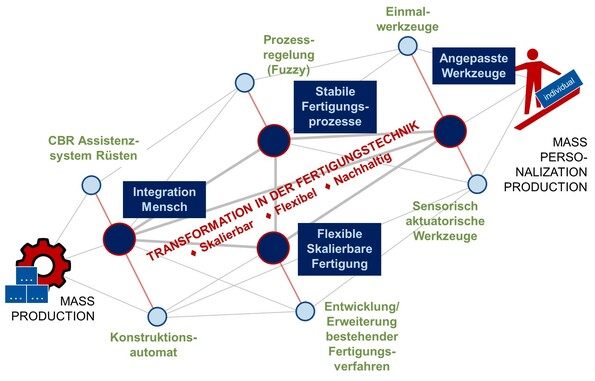
A key aspect in the transformation of manufacturing technology is the integration of people as “operators” and as “customers”. Against the backdrop of an increasing shortage of skilled workers in the manufacturing sector, ways were sought to support people so that they would be suitable for certain jobs after only a short period of instruction.

In the ERDF-funded (2016 to 2019) research project “Cyber-Setup 4.0 – Cyber-physical support of humans during the setup process using the example of a bending process for small batch production based on a knowledge transfer approach”, support for the setup and adjustment process of a bending machine was realized using AR (augmented reality). A HoloLens from Microsoft was used for this purpose, which provides the respective “operator” with the necessary information for each setup or adjustment step. Specifically, the relevant tools, their current and planned positions, any required tools, and the actions to be performed are displayed via the AR glasses. As possibilities for the insertion pictures and videos, but also holographic projections are available. Due to the flexibility of the application, the type of display and its content can be freely configured. The application can reduce setup times and avoid scrap as a result of incorrectly mounted or adjusted tools.
The integration of the human being into the manufacturing technology as a “customer” pursues the goal of leaving the definition of the product and the process to him. The definition of the product can be done on the one hand by a direct transfer of geometry data and on the other hand by a parameterized creation with the help of a design automat. Characteristic features are derived from the geometry data, on the basis of which an automated selection of possible manufacturing processes is made. This selection can be further narrowed down by describing the required product functions. If the product can be realized by processes with generic tools, the required process parameters are then determined and transferred to the next free machine after approval.
Two tool classes
If products are too complex due to their geometry or function to be manufactured with generic or existing tools, the fourth aspect of the transformation of manufacturing technology comes into play with the use of adapted tools.
The term adapted tools essentially refers to two classes of tools that are used situationally. The first tool class is that of the so-called disposable tools. These tools are predestined for single-part to small-series production and are characterized by rapid availability as well as cost efficiency. The goal is that no more than 24 hours elapse between the receipt of the order and the first manufactured product. This goal is realized through the targeted use of additive and hybrid manufacturing technologies. Depending on the requirements placed on the tool, its production can also be carried out using plastic 3D printing. Alternatively, tools can also be manufactured from sheet metal laminates, whereby tool blanks are produced by layering flat sheet metal blanks, which are given their final contour either by milling or laser buildup welding and subsequent milling.
The second tool class comprises sensory actuator tools used for mass production. These tools are designed to guarantee long-term and reliable production, with the influences of changing production conditions, such as changes in the material or the machine, being compensated for by mechanisms inside the tool. For this purpose, the rigid mold knitting surfaces are broken up and enabled by means of actuators to adjust themselves in a previously defined order of magnitude. Via sensors in the mold surface and structure, the conditions inside the mold are monitored and, if necessary, influenced by the activated mold knitting surfaces.
Web:
www.mb.uni-siegen.de
